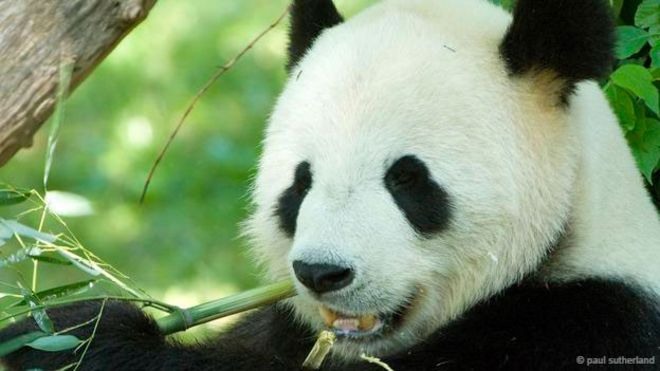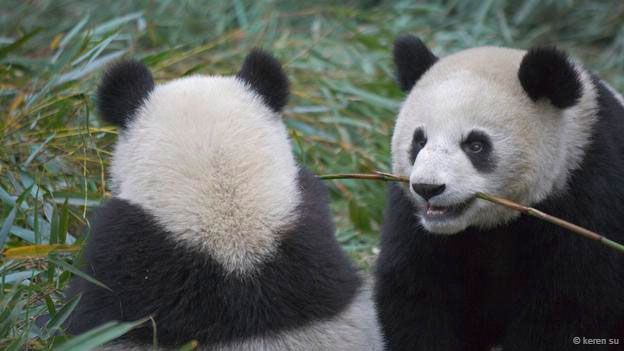专家:大熊猫不适合吃竹子 - BBC(2023年6月8日)
科学家认为,大熊猫缺乏合适的肠道菌群,无法充分消化竹子。
尽管大熊猫每天都会花费多达14个小时咀嚼约12.5千克(27.5磅)竹茎和竹叶,但它们却只能消化其中的17%左右。
中国科学家已经证明,大熊猫的肠道菌群——这是肠道内部自然存在的微观植物和动物——似乎不适合消化竹子。
大约从200万年前开始,大熊猫就一直将竹子作为唯一的食物来源,但它们的祖先却是既吃植物又吃肉的熊。
之前的研究表明,熊类的消化系统更适合吃肉,这便激发了研究人员的兴趣,他们想知道大熊猫是如何消化和吸收竹子的。

大熊猫99%的食物都是竹子(图片来源:Paul Sutherland)
他们原本以为,大熊猫的肠道菌群(这些菌群可以帮助其消化和吸收营养物质)或许已经进化出植食动物的特性。
然而,最新的研究却发现,大熊猫的肠道菌群并不包含瘤胃菌科(Ruminococcaceae)和类杆菌(Bacteroides)等可以分解植物的细菌,而是由埃希氏杆菌属(Escherichia)和链球菌属(Streptococcus)等细菌构成的。
成都大熊猫繁育基地研究员张志和说, “其他植食动物已经从结构上进化出了专门的消化系统,可以有效分解植物纤维,但大熊猫却仍然保留了典型肉食动物的胃肠道。”
另外,大熊猫也缺乏能够产生植物消化酶的基因。
“这些因素综合起来可能加大了它们灭绝的风险。”张志和博士说。
他们的详细结论已经发表在美国微生物学会出版的网络期刊《mBio》上。
为了开展这项研究,该团队收集了45只圈养大熊猫的121份粪便,使用实验室测序法来评估大熊猫的肠道菌群。
这项研究,以及之前对另外九只圈养大熊猫和七只野生大熊猫进行的研究都表明,这种动物的肠道菌群的组成种类十分相似,分别不大。

大熊猫大约从200万年前开始吃竹子(图片来源:Keren Su)
研究还显示,大熊猫的肠道菌群具有典型的杂食和肉食熊类特征,与其他植食动物完全不同,能够分解坚硬植物纤维的细菌含量很低。
因此,尽管大熊猫属于植食动物,但它却并没有很好地适应自己的高纤维饮食,这或许可以解释其消化效率低的原因。
研究人员希望展开进一步研究,了解大熊猫肠道菌群的作用和功能对其健康和营养产生的影响。
大熊猫被世界自然保护联盟(IUCN)列入“濒危物种红色名录”,全球野生成年大熊猫总数不足2500只。
这些野生大熊猫都生活在中国中南部的山区。全球圈养大熊猫总数约为300只,主要生活于中国。
根据国际自然保护联盟的数据,大熊猫整体的种群数量一直在减少。但随着栖息地环境的逐步改善,有关方面希望这一趋势可能已经开始扭转。然而,这种标志性熊类目前的状况仍然不明确。
Giant pandas' guts not suited to bamboo - By BBC NEWS
Giant pandas have the 'wrong types' of gut bacteria for efficiently digesting bamboo, scientists suggest.
Despite spending up to 14 hours per day munching about 12.5 kg (27.5 lbs) of the plants’ stems and leaves, the animals can only digest about 17% of what they consume.
Scientists in China have shown giant pandas’ gut microbiota – the microscopic plant and animal life naturally found in the intestine – have not seemingly adapted to deal with bamboo.
Giant pandas have eaten an almost exclusive bamboo diet for about 2 million years, but they evolved from bears that ate both plants and meat.
Previous research has suggested the bears’ digestive systems are better suited to a carnivorous diet, leaving researchers intrigued by how the animals actually digest and gain nourishment from bamboo.
It was thought that pandas' gut microbiota, which aid in the digestion and absorption of nutrients, may have shown a specialisation towards a herbivorous diet.
However, the results of the new study found the bears' gut microbiota is not made up of plant-degrading bacteria such as Ruminococcaceae and Bacteroides, but other bacteria such as Escherichia and Streptococcus.
“Unlike other plant-eating animals that have successfully evolved anatomically specialised digestive systems to effectively deconstruct fibrous plant matter, the giant panda still retains a gastrointestinal tract typical of carnivores,” said research team member Dr Zhihe Zhang from the Chengdu Research Base of Giant Panda Breeding, China.
Furthermore, pandas do not have the genes for producing plant-digesting enzymes.
“This combined scenario may have increased their risk of extinction,” said Dr Zhang.
Details of their findings are published in mBio, an online journal published by the American Society for Microbiology.
To carry out the research, the team examined 121 droppings from 45 captive giant pandas, using a laboratory sequencing method to evaluate gut microbiota.
The findings, together with previous examinations of nine more captive pandas and seven wild individuals, showed extremely low gut microbiota diversity.
It also shows an overall composition typical of omnivorous and meat-eating bears and entirely differentiated from other herbivores, with low levels of bacteria that are thought to break down the tough cellulose found in their bamboo diet.
The gut microbiota of this herbivore, therefore, may not have well adapted to its highly fibrous diet, suggesting a potential link with its poor digestive efficiency.
The researchers are hoping to carry out further studies to try and understand the role and function of the panda's gut microbiota on their health and nutrition.
Giant pandas are listed as endangered on the IUCN’s (International Union for Conservation of Nature) Red List of Threatened Species, with fewer than 2,500 adults left in the wild.
These populations are restricted to the mountains of south-central China. About 300 pandas are thought to live in captivity, mainly in China.
According to the IUCN there has been a general population decline in giant pandas, but it is hoped this may have begun to reverse due to habitat improvements. However the current status of the iconic bear remains unclear.